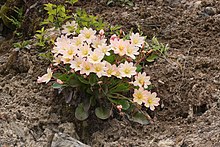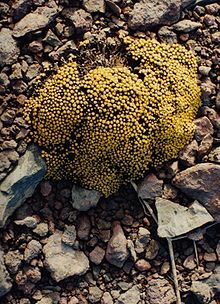Spring herbs
| Spring herbs | ||||||||||||
|---|---|---|---|---|---|---|---|---|---|---|---|---|

|
||||||||||||
| Systematics | ||||||||||||
|
||||||||||||
| Scientific name | ||||||||||||
| Montiaceae | ||||||||||||
| Raf. |
The spring herbaceous plants (Montiaceae) are a family in the order of the carnation-like (Caryophyllales) within the flowering plants . The 15 or so genera are mainly found in the New World . Some species are used as ornamental plants and a few species as food plants.
description


Vegetative characteristics
There are annual to perennial herbaceous plants , some species are subshrubs ( Montiopsis ). Some species are more or less succulent ( e.g. Lewisia ). The internodes are short. There is little secondary growth in thickness . In some species, the roots and basal leaves are thickened.
The leaves are often arranged in rosettes. The leaves often have a base that encompasses the stem. The longitudinally arranged stomata are paracytic. The waxes on the cuticle are present as adjacent platelets. All parts of the plant are hairless.
Generative characteristics
The flowers are axillary solitary or in terminal (often monochasial) zymous inflorescences .
There are four to five (to nine) petal-like bracts . There are three to 100 stamens that are fused at most at their base. The pollen grains are therefore tricolpat or pantoporat ( Montia ). Two to eight carpels have become a top permanent ovary grown. There are four to seven ovules in free central placentation .
A kind of capsule fruit is formed.
Chromosome number
The chromosome numbers are n = 6-13 or more.
ingredients
The species in the family include betalaine .
Systematics
External system
These species used to be part of the purslane family (Portulacaceae). Molecular biological studies have suggested that the Montiaceae family makes a monophyletic taxon . There remains only the genus purslane ( Portulaca ) in the monophyletic characterized family Portulacaceae. (Applequist et al. 2006, Nepokroeff et al. 2002 and Nyffeler et al. 2008)
Within the order of the carnation-like (Caryophyllales) the Montiaceae are closely related to the Didiereaceae , Cactaceae , Halophytaceae , Portulacaceae , Anacampserotaceae , Talinaceae and Basellaceae ; these eight families can be summarized as the suborder Portulacineae.
Internal systematics and distribution
The Montiaceae family was founded in 1820 under the name "Montidia" by Constantine Samuel Rafinesque-Schmaltz in Annales Générales des Sciences Physiques , Volume 5, page 349. A synonym for Montiaceae Raf. is Hectorellaceae Philipson & Skipworth .
The Montiaceae family has a wide distribution area , especially in western North America and western South America , but also on the Caribbean islands , New Zealand and the sub-Antarctic islands .
The Montiaceae family comprises the following 15 genera:
- Calandrinia Kunth (Syn .: Monocosmia Fenzl ): It contains about 14 species; they occur in western North America, Central America, and western South America.
- Calyptridium Torr. & A.Gray (Syn: Spraguea Torr. ) It contains about 14 species. They occur in America.
- Cistanthe Spach (Syn: Silvaea Phil. ) It contains about 20 species. They occur in America.
- Plate herbs or Claytonia ( Claytonia L. , Limnia Haw. ): The approximately 27 species occur in North America and East Asia . Two types are neophytes in Europe.
-
Hectorella Hook. f. : There is only one type:
- Hectorella caespitosa Hook. f. : It occurs in New Zealand .
-
Lenzia Phil .: There is only one type:
- Lenzia chamaepitys Phil .: It occurs in Chile .
- Lewisia Pursh (Syn .: Erocallis Rydb. , Oreobroma Howell ): The 16 to 19 species are common in western North America.
-
Lewisiopsis Govaerts : There is only one species:
- Lewisiopsis tweedyi (A.Gray) Govaerts : It occurs in western North America in the Canadian province of British Columbia and in the US state of Washington.
-
Lyallia Hook. f. : There is only one type:
- Lyallia kerguelensis Hook. f. : This endemic occurs only on the Kerguelen .
-
Spring herbs ( Montia L. , Syn .: Claytoniella Jurtzev , Crunocallis Rydb. , Limnalsine Rydb. , Maxia Ö.Nilsson , Mona Ö.Nilsson , Montiastrum (A.Gray) Rydb. , Naiocrene (Torr. & A.Gray) Rydb. , Neopaxia Ö.Nilsson , Paxia Ö.Nilsson ): There are about 12 species, including:
- Bach spring herb ( Montia fontana L. )
- Montiopsis Kuntze (Syn .: Calandriniopsis E. Franz ): The 18 to 40 species are common in western South America and are particularly common in Chile.
- Parakeelya Hershk. : There are 40 to 70 kinds.
- Phemeranthus Raf. : The 25 to 30 species are common in the New World .
- Philippiamra Kuntze (Syn .: Diazia Phil. , Silvaea Phil. ): It contains about eight species.
-
Schreiteria Carolin : There is only one type:
- Schreiteria macrocarpa (Speg.) Carolin : Little is known about this species. It was only found in the northern part of the Argentine province of Tucumán , but has not been collected again since the 1930s.
swell
- The family of Montiaceae in APWebsite . (Section systematics)
- Included in DELTA in Portulacaceae. (engl.)
- Same text online as the printed work , In: Flora of North America Editorial Committee (Ed.): Flora of North America North of Mexico. Volume 4: Magnoliophyta: Caryophyllidae, part 1. Oxford University Press, New York and Oxford, 2003, ISBN 0-19-517389-9 . (In the Flora of North America , the genera are still included in the Portulacaceae family.)
- Wendy L. Applequist, Warren L. Wagner , Elizabeth A. Zimmer, Molly Nepokroeff: Molecular evidence resolving the systematic position of Hectorella (Portulacaceae). In: Systematic Botany , Volume 31, 2006, pp. 310-319.
- Reto Nyffeler, Urs Eggli, Matt Ogburn, Erika Edwards: Variations On A Theme: Repeated Evolution Of Succulent Life Forms In the Portulacineae (Caryophyllales). In: Haseltonia , Volume 14, 2008, pp. 26–36: PDF-Online .
Individual evidence
- ↑ a b Eckehart J. Jäger (Hrsg.): Rothmaler Exkursionsflora von Deutschland, Vascular Plants Baseline , 20th Edition, Spectrum, 2011, p. 608.
- ^ Montiaceae at Tropicos.org. Missouri Botanical Garden, St. Louis, Retrieved September 18, 2017.
- ↑ a b c d e f g h i Montiaceae in the Germplasm Resources Information Network (GRIN), USDA , ARS , National Genetic Resources Program. National Germplasm Resources Laboratory, Beltsville, Maryland. Retrieved September 21, 2017.
- ↑ a b c d e f g h i j k l m n o p Reto Nyffeler, Urs Eggli: Disintegrating Portulacaceae: A new familial classification of the suborder Portulacineae (Caryophyllales) based on molecular and morphological data. In: Taxon , Volume 59, Number 1, 2010, pp. 227-240. Full text PDF.
- ↑ a b c d e f g h i David John Mabberley: Mabberley's Plant-Book. A portable dictionary of plants, their classification and uses . 3rd ed. Cambridge University Press 2008. ISBN 978-0-521-82071-4
- ^ Robert W. Kiger: New combinations in Phemeranthus Rafinesque (Portulacaceae). In: Novon , Volume 11, Issue 3, 2001, pp. 319-321. doi : 10.2307 / 3393037 JSTOR 3393037
- ↑ Robert W. Kiger: http://www.efloras.org/florataxon.aspx?flora_id=1&taxon_id=10724 Phemeranthus Rafinesque. - Same text online as the printed work , In: Flora of North America Editorial Committee (Ed.): Flora of North America North of Mexico. Volume 4: Magnoliophyta: Caryophyllidae, part 1 , Oxford University Press, New York and Oxford, 2003, ISBN 0-19-517389-9 .




